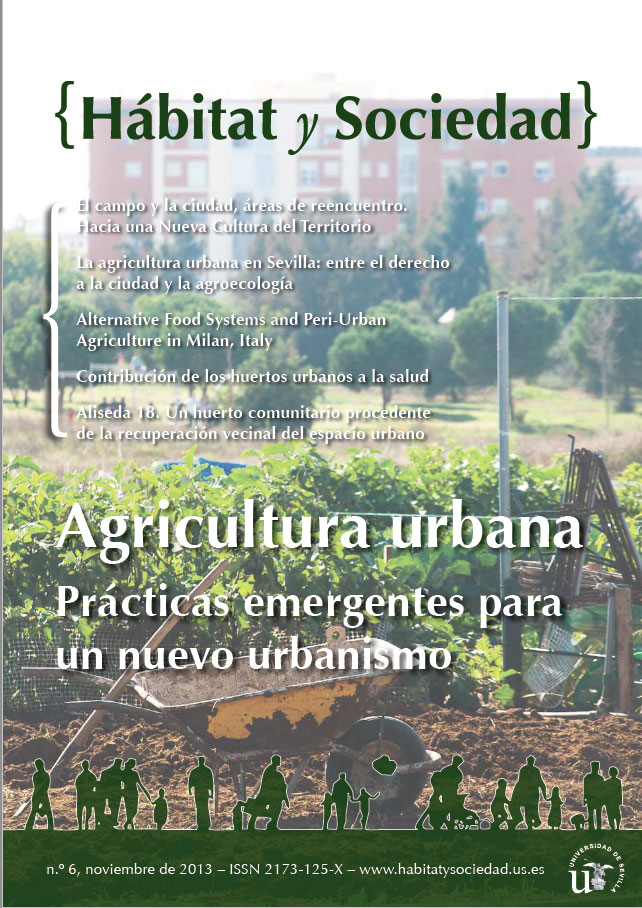Contribución de los huertos urbanos a la salud
DOI:
https://doi.org/10.12795/HabitatySociedad.2013.i6.05Palabras clave:
Agricultura urbana, Huertos urbanos, Salud, Sostenibilidad urbana, Estilos de vida.Resumen
La inclusión de espacios para la agricultura en las ciudades se presenta como una potencial herramienta de promoción de entornos urbanos saludables y sostenibles, pudiendo ser especialmente beneficiosapara colectivos vulnerables. El objetivo de este estudio es analizar los efectos percibidos sobre la salud por personas mayores de 65 años que participan en una red de huertos ya instaurada en Barcelona. Se llevó a cabo un diseño exploratorio-descriptivo, realizando entrevistas semiestructuradas a seis hortelanos de Barcelona para analizar sus percepciones acerca de la influencia de la participación en los
huertos sobre su salud. Los hortelanos manifestaron haber percibido un incremento en su actividad física, en la calidad (aunque no en la cantidad) de las verduras que consumen y en sus relaciones sociales, y beneficios en su bienestar psicológico. Las diferentes aportaciones de los huertos urbanos observadas en este estudio y en investigaciones anteriores sugieren que destinar espacio para la agricultura en las ciudades podría contribuir a fomentar entornos y estilos de vida saludables y una mayor sostenibilidad urbana, por lo que se plantea como una posible estrategia para abordar múltiples problemas de forma transversal.
Descargas
Citas
ALAIMO, K. et al. Fruit and vegetable intake among urban community gardeners. Journal of Nutrition, Education and Behaviour, 2008, vol. 40, nº 2, p. 94-101.
ARMSTRONG, D. A survey of community gardens in upstate New York: implications for health promotion and community development. Health & Place, 2000, vol. 6, nº 4, p. 319-327.
BELLOWS, Anne C., BROWN, Katherine y SMIT, Jac. Health Benefits of Urban Agriculture. Community Food Security Coalition, 2003. Disponible en: <http://www.co.fresno.ca.us/uploadedFiles/Departments/Behavioral_Health/MHSA/Health%20Benefits%20of%20Urban%20Agriculture%20(1-8).pdf>(consultado el 3 de julio de 2014).
DÁVILA QUINTANA, Carmen Delia y GONZÁLEZ LÓPEZ-VALCÁRCEL, Beatriz. Crisis económica y salud. Gaceta Sanitaria, 2009, vol. 23, nº 4, p. 261-265.
DUHL, Leonard y HANCOCK, Trevor. Healthy cities, healthy children. The Progress of Nations - UNICEF, 1997, p. 59-61.
EVANS, Robert G., BARER, Morris L. y MARMOR, Theodore R. ¿Por qué alguna gente está sana y otra no?: los determinantes de la salud de las poblaciones. Madrid: Díaz de Santos, 1996.
FAO. Declaración de la Cumbre Mundial sobre la Seguridad Alimentaria. Roma: FAO, 2009.
GALEA, S. Y VLAHOV, D. Urban health: Evidence, Challenges and Directions. Annual Review of Public Health, 2005, vol. 26, nº 1, 341-365.
GROENING, Gert. The World of Small Urban Gardens. Chronica Horticulturae, 2005, vol. 45, nº 2, p.22-25.
HANCOCK, Trevor, 2007, Creating environments for health — 20 years on. Global Health Promotion, 2007, nº 14, supl. 2, p. 7-8.
Hanlon, P. y Mccartney, G. Peak oil: Will it be public health’s greatest challenge? Public Health, 2008, vol. 122, nº 7, 647-652.
HEALTH COUNCIL OF THE NETHERLANDS. Nature and health. The influence of nature on social, psychological and physical well-being. La Haya: Health
Council of the Netherlands and RMNO, 2004. Nature and health. Disponible en: <http://www.gezondheidsraad.nl/sites/default/files/Nature_and_
health.pdf> (consultado el 3 de julio de 2014).
INFANTINO, Mary. Gardening: a strategy for health promotion in older women. The Journal of the New York State Nurses’ Association, 2005, vol. 35, nº 2, p. 10-17.
JACKSON, L. E. The relationship of urban design to human health and condition. Landscape and Urban Planning, 2003, vol. 64, nº 4, 191-200.
KHARICHA et al. Health risk appraisal in older people 1: are older people living alone an “at-risk” group? The British Journal of General Practice, 2007, vol. 57, nº 537, p. 271-276.
LARGO-WIGHT, E. Cultivating healthy places and communities: evidenced-based nature contact recommendations. International Journal of Environmental Health Research, 2011, vol. 21, nº 1, 41-61.
MAAS, J. et al. Green space, urbanity, and health: how strong is the relation? Journal of Epidemiology and Community Health, 2004, vol. 60, nº 7, p. 587-592.
MCGRANAHAN, G. y SATTERTHWAITE, D. Urban Centers: An Assessment of Sustainability. Annual Review of Environment and Resources, 2003, vol. 28, nº 1, p. 243-274.
MCMICHAEL, A. J. The urban environment and health in a world of increasing globalization: Issues for developing countries. Bulletin of the World Health Organization, 2000, vol. 78, nº 9, p. 1117-1126.
MILLIGAN, C., GATRELL, A. y BINGLEY, A. Cultivating health’: therapeutic landscapes and older people in northern England. Social Science & Medicine, 2004, vol. 58, nº 9, p. 1781-1793.
MORÁN, Nerea. Huertos urbanos en tres ciudades europeas: Londres, Berlín, Madrid [online]. Madrid, 2009, p. 4. Disponible en: <http://surcosurbanos.es/HUERTOS_URBANOS_2009.pdf> (consultado el 3
de julio de 2014).
MOUGEOT, L. J. Urban agriculture: definition, presence, potentials and risks. En BAKKER, N. et al. (Eds.). Growing cities, growing food: Urban agriculture on the policy agenda. Alemania: DSE, 2000, p. 10.
PECURUL, Mireia, CRISTÓBAL, Roser y MOSCOSO, David J. La contribución de los espacios verdes y los bosques a la mejora de la salud y al bienestar. Ambienta, 2006, nº 60. Disponible en: <http://digital.csic.es/handle/10261/2064> (consultado el 3 dejulio de 2014).
PUENTE ASUERO, Raúl. Urbanizar con huertos. Cimbra, 2010, p. 24-29.
RIECHMANN, Jorge, 2009, La crisis energética: algunas consideraciones políticas. Economía Industrial, 2009, nº 371, p. 37-48.
SALAMANCA CASTRO, Ana Belén y MARTÍN-CRESPO BLANCO, Cristina. El muestreo en la investigación cualitativa. Nure Investigación, 2007, nº 27.
SMIT, J, 1996, Urban agriculture: food, jobs and sustainable cities. En: Publication Series for Habitat II. United Nations Development Programme, 1996.
SOCIEDAD ESPAÑOLA DE SALUD PÚBLICA Y ADMINISTRACIÓN SANITARIA. Informe SESPAS 2006. Los desajustes de la salud en el mundo desarrollado. Gaceta Sanitaria, 2006, vol. 20, supl. 1. Disponible en: <http://www.sespas.es/ind_lib08.html>consultado el 3 de julio de 2014).
SOCIEDAD ESPAÑOLA DE SALUD PÚBLICA Y ADMINISTRACIÓN
ANITARIA. Informe SESPAS 2011. La Salud Pública en la sociedad española: Hacia la salud en todas las políticas. Gaceta Sanitaria, 2011,
vol. 26, supl. 1.
TIBBETTS, John. Building civic health. Environmental Health Perspectives, 2003, vol. 111, nº 7, p. 400-403.
UNITED NATIONS, World Urbanization Prospects: The 2011 Revision. Department of Economic and Social Affairs, 2011. Disponible en: <http://esa.un.org/unpd/wup/index.htm> (consultado el 3 de julio
de 2014).
VAN DEN BERG, A. E. et al. Allotment gardening and health: a comparative survey among allotment gardeners and their neighbours without an allotment.
Environmental Health, 2010, vol. 9, nº 74. VARGAS MARCOS, F. La contaminación ambiental como factor determinante de la salud. Revista Española de Salud Pública, vol. 79, nº 2, 17-127.
WACKERNAGEL, M. Urban ecological footprints: Why cities cannot be sustainable - and why they are a key to sustainability. Enviromental Impact Asses Rev, 1996, nº 16, p. 223-248.
WAKEFIELD, S. et al. Growing urban health: community gardening in South-East Toronto. Health Promotion International, 2006, vol. 22, nº 2.
World Energy Outlook: 2010. Executive Summary. Francia:
International Energy Agency, 2010. Disponible en: <http://www.worldenergyoutlook.org/media/weowebsite/2010/WEO2010_es_english.pdf> (consultado el 3 de julio de 2014).
Descargas
Publicado
Cómo citar
Número
Sección
Licencia
Derechos de autor 2017 De los autores y Editorial Universidad de Sevilla

Esta obra está bajo una licencia internacional Creative Commons Atribución-NoComercial-CompartirIgual 4.0.
Los textos publicados se considerarán propiedad intelectual de los autores y de la revista. Podrán ser usados para usos educativos y académicos, citando al autor y la publicación, con la dirección electrónica exacta. En todo caso, deberá comunicarse este tipo de uso y pedir la autorización del mismo a la dirección de la revista.
Los autores/as que publiquen en esta revista aceptan las siguientes condiciones:
- Los autores/as conservan los derechos de autor y ceden a la revista el derecho de la primera publicación, con el trabajo registrado con la licencia de atribución de Creative Commons, que permite a terceros utilizar lo publicado siempre que mencionen la autoría del trabajo y la primera publicación en esta revista.
- Los autores/as pueden realizar otros acuerdos contractuales independientes y adicionales para la distribución no exclusiva de la versión del artículo publicado en esta revista (p. ej., incluirlo en un repositorio institucional o publicarlo en un libro) siempre que indiquen claramente que el trabajo se publicó por primera vez en esta revista.
- Se permite y recomienda a los autores/as publicar su trabajo en Internet (por ejemplo en páginas institucionales o personales) antes y durante el proceso de revisión y publicación, ya que puede conducir a intercambios productivos y a una mayor y más rápida difusión del trabajo publicado (véase The Effect of Open Access).













